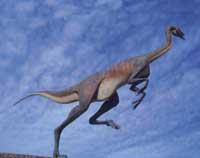Did dinosaurs really destroyed?
1997/09/01 Nuñez-Betelu, Koldo Iturria: Elhuyar aldizkaria
One of the objectives of paleontology is to investigate the evolution of life, that is, how species have arisen and disappeared, and the information obtained is collected in the Theory of Evolution. According to this theory, the origin of all living beings is in a single being and the present living beings have been created by the transformation of their ancestors. This theory, therefore, tries to explain how new species of origin are created, analyzing in detail the characteristics of each being, their relationships between beings and their relationships with the environment.
When he published the Theory of Evolution, Darwin was asked to show what species could be transitions between different species. Two years after the appearance of the theory, the discovery of the fossil bird Archaeopteryx lithographica, which lived 145 million years ago, came to push, at least in part, the ideas of Darwin. It is a bird with numerous characteristics of reptiles, but in turn with numerous feathers, which makes it an animal between reptiles and birds. However, the famous Archaeopteryx was a very primitive bird that could fly in a very clumsy way, with long jumps as much. Therefore, between the Archaeopteryx and the real birds there was still a large gap to fill with transitional species.
Two new discoveries have come to fill this hole in recent months. On the one hand, the dinosaur Unenlagia comahuensis, discovered in the Upper Cretaceous of Argentina, and on the other, a new fossil chorizo of Lleida.
The first, Unenlaga, has been found in rocks of 90 million years1. Although no feather is known, birds are characterized by their anterior limbs folded as wings and by their pelvis between reptiles and birds.
The second is the beautiful fossil of a bird discovered by an amateur eight years ago in the lithographic limestones of La Pedrera in the massif of El Montsec, in the province of Lleida. This little bird, as shown by bone foramines, was still enough to be in the nest, but due to an accident, perhaps learning to fly, fell into the local lake, drowned and buried in bottom clays 135 million years ago. This duck of the size of a sparrow appears in rocks of 10 million years after the Archaeopteryx. Its skull has many characteristics of sauriscous dinosaurs, carnivores. On the contrary, birds have characteristics of birds such as wings and feathers.
On the other hand, paleontologists explain that dinosaurs disappeared 65 million years ago, at the end of the Cretaceous, per secula seculorum. However, the birds were not destroyed. However, if the bird is a modified dinosaur, and this is demonstrated by its characteristics, we will have to say that the dinosaurs did not disappear and that they managed to remain converted into birds.
However, there are still paleontologists who do not accept this hypothesis. According to them, the origin of birds and dinosaurs is found in two hypothetical branches different from the very primitive reptiles that lived in Arkosaurio, that is, 250 million years ago. However, these two branches have not been discovered by anyone and never seem to have occurred.
Finally, as in its day Archaeopteryx promoted Darwin's theory, we can say that the last fossils found in Argentina and Lleida demonstrate the evolution of a dinosaur branch. The discoveries show that dinosaurs were not completely destroyed and that they managed to survive in other types of creatures, birds.

Gai honi buruzko eduki gehiago
Elhuyarrek garatutako teknologia





